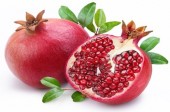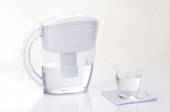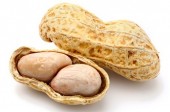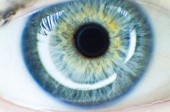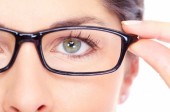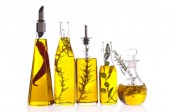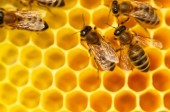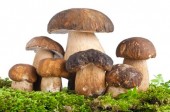Search Podcasts
Packed with powerful antioxidants and nutrients, this fruit boosts your overall health.
Additional Info
- Segment Number 1
- Audio File healthy_talk/1509ht3a.mp3
- Guest Website Healthy Talk MD
-
Transcription
RadioMD Presents: Healthy Talk | Original Air Date: February 25, 2015
Host: Michael Smith, MD
Anti-aging and disease prevention radio is right here on RadioMD. Here's author, blogger lecturer and national medical media personality, Dr. Michael Smith, MD with Healthy Talk.
I love pomegranate. You know, I do a lot of lectures. I speak at a lot of conferences and very rarely do I present any health information without talking about pomegranate. I think it's just about in every slide deck that I have; every PowerPoint presentation that I have.
My love affair with this amazing fruit goes back to my childhood. I grew up to about age 12 in California in two places: Redlands, California, and Mission Viejo, California, which is more south than Orange County. But when we were in Redlands, just beyond our back yard was a huge orange grove and throughout the orange grove were pomegranates. I remember going out there with my brother. First of all, we just loved to be out in the orange grove. It was just a great place for two young boys to play and have fun and I remember really being attracted to the pomegranates. We used to eat them out there. I know this sounds wasteful, but we were kids. We used to break them on rocks and pretend the red dye was like blood and all that kind of stuff. I mean, we were just kids. I remember sometimes coming in from the orange grove and when my mom saw us coming from that direction, she came out in the back yard and she stopped us and washed us down because we had pomegranate juice all over us which was sticky and red and stained everything. My poor mom.
So, I want to talk about 5 well-established benefits of pomegranate today. The inspiration of this segment came from PakistanTribe.com. You know, I do belong to a lot of different organizations and websites that are in the near East, Middle East, Far East, because they tend to be a little bit ahead of the curve when it comes to natural medicine, at least compared to the United States. So, I get a lot of good ideas from websites like PakistanTribe.com. I've confirmed all of these, too.
I already knew this. I mean, I love pomegranate, as I said. You know, by the way, pomegranate goes way back in time in terms of literature. It's been written up as far as back as Mesopotamia, the Babylonian, even the Hebrew bible. I mean, all of these ancient cultures recognized pomegranate as a vitality fruit and it's written about in all of those old scriptures and holy books. So, I took the benefits here that the PakistanTribe.com wrote about and I've confirmed them, of course. The first one I want to mention, one of the key benefits of pomegranate, is the heart.
There are a couple of things about pomegranate that it does for the heart that are very important. Number one is, it increase nitric oxide production. That's very important. Nitric oxide is a key chemical in the cardiovascular system. It is produced by the endothelial cell that lines the inside of the arteries. When those cells are healthy, you have the healthy cardiovascular system. The way we measure endothelial health is through nitric oxide production. Anything that is able to boost nitric oxide production is believed that that is really helping the endothelial cell function at a more optimal level.
That's exactly what pomegranate does. There are some studies showing that pomegranate extract can increase nitric oxide production by 15-20%. I mean, that's pretty significant. So, that's number one. Pomegranate goes directly to the health of the inside lining of the artery. Very, very important.
Another key heart benefit of pomegranate is its effect on blood pressure.
Now, if something like pomegranate increases nitric oxide, the vessels dilate a little bit easier and that's going to help to manage blood pressure. That's one way, that's one mechanism, that pomegranate improves blood pressure. But, there's another way. There's more research showing that the phytochemicals—these key compounds, these antioxidants, in pomegranate act like, basically, ACE inhibitors which are a class of blood pressure drug. So, pomegranate is not just helping blood pressure through nitric oxide, it's also acting through a very important mechanism for blood pressure control. This comes out of a study from Atherosclerosis. That's a key journal, right? Peer review journal, 2001. They studied the effects of pomegranate juice consumption for 2 weeks in hypertensive patients. They actually measured blood pressure and the level of what is called the "angiotensin converting enzyme activity" (ACE enzyme activity) because the theory is that pomegranate can inhibit it.
What they found was a 36% drop in serum ACE activity and a 5% reduction in systolic blood pressure. That's with pomegranate juice. They also noted that in some patients, there was a drop in the ACE activity, the ACE enzyme, but there wasn't an association with a drop in blood pressure. However, the interesting thing about this study was that they noted that even though blood pressure wasn't dropping, simply by controlling the ACE enzyme, that has benefit towards arterial plaque formation and what we call "heart cell remodeling" especially in people who have known heart disease. So, even though in some of these patients, blood pressure maybe didn't drop all that much, just by controlling the activity of this enzyme called "ACE", pomegranate was able to improve their overall cardiovascular status. So, that's really good news there.
So, number one benefit of pomegranate: heart. Nitric oxide production and controlling the activity of the ACE enzyme.
Number two benefit of pomegranate would be with cancer. We already know that in addition to the antioxidants, there are other types of phytochemicals in pomegranate that have been shown to be beneficial in breast cancer, prostate and even lung. In particular, what we're finding with at least breast cancer is, some of these phytochemicals are able to inhibit some of the enzymes in the liver that produce estrogen metabolites that tend to be more proliferative. So, there are thousands of types of estrogens in the body, actually. Estrogen is heavily metabolized and some of those metabolites can be quite proliferative on breast tissue, ovarian tissue, endometrial tissue and it turns out pomegranate can inhibit the enzyme that produces some of those more aggressive type of estrogen.
So, there's cancer prevention for pomegranate besides heart.
Number three, maybe pomegranate might be helpful in arthritis. There was a 2005 study from the Cape Western Reserve University School of Medicine and researchers there discovered that an enzyme in pomegranate slowed the breakdown of cartilage that leads to osteoarthritis. They also believe that pomegranate has some anti-inflammatory effects which could be very helpful, obviously, in arthritis. So, there are some arthritis benefits to it.
Now, this next benefit was somewhat new to me and it had to do with the teeth—clean teeth. It turns out pomegranate doesn't just help plaque build-up in the arteries, but it can also decrease plaque in teeth. Now, this is still being researched. It's not well-established yet, but we do think here at Life Extension, for instance, that this is something that we should continue to watch. We even have a toothpaste that we added a little bit of pomegranate to it anticipating some positive results here reducing plaque build-up—not just in your arteries, but also in your teeth. Pomegranate. That's pretty awesome.
Then, of course, as a longevity company and as the senior scientist for a longevity company, Life Extension, we obviously focus on nutrients that have the ability to help us live longer, right? That's what we do and there are a variety of mechanisms that may work: anti-oxidation, anti-inflammation. Guess what? Pomegranate fulfills a lot of those roles, so there's some aging support in pomegranate as well.So, yes, eat it, drink it, bathe in it. It's wonderful.
This is Healthy Talk on RadioMD. I'm Dr. Mike. Stay well. - Length (mins) 10
- Waiver Received No
- Internal Notes NO GUEST
- Host Mike Smith, MD
Listen in as Dr. Mike provides the answers to a wealth of health and wellness questions.
Additional Info
- Segment Number 5
- Audio File healthy_talk/1509ht2e.mp3
- Organization Life Extension
- Guest Website Healthy Talk MD
-
Transcription
RadioMD Presents: Healthy Talk | Original Air Date: February 24, 2015
Host: Michael Smith, MD
It’s time to Ask Dr. Mike on Healthy Talk. Do you have a question about your health? Dr. Mike can answer your questions. Just email: AskDrMikeSmith@RadioMD.com or call: 877-711-5211. The lines are open.
I would love to hear from you. Give me a call. 877-711-5211 and you can also send your emails to AskDrMikeSmith@RadioMD.com.
Next question. “I still don’t understand why you push a multivitamin.” Well, I wrote a book called The Supplement Pyramid and I consider a multivitamin a foundational product. As a matter of fact, they go on to say, “You call it a foundational product in your book, but if I’m eating all organic fruits and vegetables and a lot of them, I think it’s overkill. You said in your book that our soils are poor, yet I purchase from a local farmer who takes care of his soil.” That’s kind of how this person ended it.
Yeah. Well, okay. That’s awesome. I would encourage all of us to use local farmers and locally produced food. I think that’s a great way to eat and I do trust that produce better. You know, I think it is going to be more nutritious. So, yeah. That’s good that you’re doing that, but let’s just talk about something else in my book that I mentioned that you didn’t put here is this concept of ideal daily intake—the IDI—ideal daily intake. That’s a phrase that I just totally made up for the book, but it’s based on science. It’s based on the studies. So, we know that most of our doctors in this country, nutritionists, even most of the multivitamins on the market are based on a dosing system called the “recommended daily intake”, and “recommended daily allowance”. They are very similar dosing systems and basically they were developed during a time right after or during and right after World War II when people weren’t getting near enough vitamins and minerals, so the RDA and the RDI of say, something like Vitamin C, which is 50 mg, was set because that was the lowest level you could get and not get scurvy. So, the current dosing system that we continue to use today is really about preventing vitamin deficiencies. Well, here’s the interesting point about this. Most of the food sources are pretty close to providing the RDI and RDA. They also looked at the food sources. They said, “Okay. How much Vitamin C do I need to prevent scurvy and what do I find in most food sources?” The best answer that they came up with was about 50-90 mg. That’s for Vitamin C, the RDI. So, it was based on preventing scurvy and what they found in most produce, like an orange. So, if you eat an orange, you’re going to get a decent amount of Vitamin C and probably enough to prevent scurvy. So, that’s great that you’re going to the local farmer and I think that’s wonderful. And, by the way, if you think, in your particular case—because I’m all about personalizing regimens—so, if you think in your personal life that right now, the multivitamin would be overkill, that’s fine. I personally don’t think it is, but if you do, I’m not going to argue that point. But what I am going to say is, most of your organic, locally grown produce which is awesome—that’s how I want people to eat—is still not providing ideal doses of these vitamins. Now, let’s go back to Vitamin C, okay? So, the recommended daily intake of Vitamin C is between 50 and 90. That was developed in the 1940’s to prevent scurvy and that’s what you find in most fruits and vegetables that provide Vitamin C, right? So that way, if you eat an orange, you know you’re going to prevent scurvy. That’s kind of how they came up with that dosing system.
However, what about today? You know, 2015? We are very blessed in this country where we don’t have to worry so much about scurvy. There are some people that do and we need to address hunger in this country better, no doubt. But, most of us, thank God, don’t have to worry about scurvy. So, what about all the other health attributes of Vitamin C. You know? Like anti-cancer, cardiovascular health, immune support. What type of dosing do I need to achieve those benefits? Well, that’s where I came up with the ideal daily intake. I went into the science. I looked at the cancer studies of Vitamin C. I looked at the cardiovascular study of Vitamin C. I looked at the immune studies with Vitamin C and what you overwhelmingly find is a dose range of about 500 mg to 2000 mg of Vitamin C to obtain those benefits. That’s far beyond 50 mg. That’s far beyond just preventing scurvy. You know, we’re taking Vitamin C into a whole new level of health, okay? And, that local farmer is not producing a serving of an orange that has 500 mg of Vitamin C. They’re just not unless they’re totally genetically modifying it, which we don’t want, right?
So, there you go. So, I go back to my point that I still think, even in a situation where you are personally taking care of your food sources, you’re buying from local farms—that’s great. You’re doing organic, you’re getting your full servings of fruits and vegetables. The question is, how much Vitamin C, for instance, is that actually providing you? It’s probably not providing you the 500 mg which is where all of those other health benefits begin—the ideal daily intake. So, my case is, we still need a multivitamin. Okay. But if you don’t want one, that’s fine. You’re doing great. But, that’s just giving you my two cents in all that. So, I do think a multivitamin is essential today. One last little point about this, too. We have to look at the environment we live in. You know, it’s toxic. I mean, we are asking our internal organs to function in an environment that is saturated with industrial toxins and pro-oxidants, pro-inflammatory compounds, compounds that act like estrogens in our body from pesticides and all this kind of stuff. We are asking the human body to thrive, we’re asking our bodies to function at an optimal level, in an environment that we’ve never experienced before as humans. Again, I think it’s just another need for the foundational products that I talk about in The Supplement Pyramid--a multivitamin, CoQ10, Omega-3 oils, probiotics. I mean, those are foundational products and it’s not just about poor soil. It’s not just about sick food chains. It’s really also about the environment we live in. So, I stand by those foundational products.
Okay. So, I went way longer on that one. Real quickly. I don’t think I have time for this water filter one. Well, I’ve got a couple minutes my producer just said, so here’s the question. “Is there really a difference between water filters? Like reverse osmosis, higher pH and basic ones? We pull water from a well and my iron levels are high, so I definitely need a filter.” So, that is important. We’ve got to watch. Iron is a strong pro-oxidant, speaking of the environment. We need a little bit of iron, but we don’t need to be supplementing with it. We don’t need extra iron from our water, so that’s good that you recognize you need a filter. I’m not a water filter expert. I do a very basic Brita water filter. It works fine for me, but I did go to help answer this question, to the Environmental Working Group where they’ve kind of listed out what they think are the best types of water filters. Of course, activated carbon is at the top. Next came what is called a carbon block filter. This one I wasn’t familiar with. Carbon block filters contain pulverized activated carbon that is shaped into blocks under high pressure. And, it apparently works pretty good, but not as good as the activated carbon filters. Then there’s the granulated activated carbon filters that they don’t have enough information on yet, but they look promising. Ceramic filters. These have very small holes throughout the material that blocks solid contaminants such as cysts and sediments, but they’re not all that great at removing chemical contaminants. Then, there are the deionized filters. They rank them about the same level as the ceramic filters. Then, you have distillation filters which come last. So you know what? The Environmental Working Group still ranks activated basic carbon filters as the best ones. So, there you go.
This is Healthy Talk on RadioMD. I’m Dr. Mike.
Stay well.
- Length (mins) 10
- Waiver Received No
- Internal Notes NO GUEST
- Host Mike Smith, MD
Listen in as Dr. Mike provides the answers to a wealth of health and wellness questions.
Additional Info
- Segment Number 4
- Audio File healthy_talk/1509ht2d.mp3
- Organization Life Extension
- Guest Website Healthy Talk MD
-
Transcription
RadioMD Presents: Healthy Talk | Original Air Date: February 24, 2015
Host: Michael Smith, MD
You’re listening to RadioMD. It’s time to Ask Dr. Mike on Healthy Talk. Call or email to ask your questions now. Email: AskDrMikeSmith@RadioMD.com or call: 877-711-5211. The lines are open.
So, my first question comes from Bart Taylor. He says, “Hi, Dr. Mike. What is the deal with magnesium stearate? It seems that most supplement companies put this in all their products.” So, magnesium stearate is—some people think it’s a preservative. That’s not what it is. It’s a flow agent. What that means is, in the manufacturing process in order to keep the active powders that are eventually going to fill up the capsule, in order to prevent them from clumping and keeping them flowing through the machinery, essentially, magnesium stearate is used. It prevents that clumping. It allows the material to go through the manufacturing process, eventually ending up in that capsule so that you can take it as a supplement.
Some of the magnesium stearate does end up in that capsule as well. However, it’s pretty miniscule. It’s a pretty small amount. It’s pretty insignificant overall. Now, I know that some health experts with some pretty famous websites have come out really strongly against magnesium stearate and I’ve got to be honest with you, Bart. I think it’s a little overblown. I don’t think you want high quantities of magnesium stearate in your system but you’re talking about very, very small amounts—almost unmeasurable—that actually end up in the capsule. Without it, we wouldn’t be able to make these capsules. Let’s also look at how it’s made—magnesium stearate. It’s magnesium—that’s not bad. And it’s stearic acid, which is a saturated fat. Again, if you overdo saturated fats, that’s not good but, we’re talking about very little amounts actually coming into the capsule. So, it’s magnesium and a saturated fat—stearic acid. So again, I think some of these claims have been overblown. I looked it up. It looks like most of the negative press for magnesium stearate started in the 1990’s and there was a study that’s often quoted by doctors against its use, but when you really look at this study, I don’t know why they’re quoting this study. In this particular study that started all of this stuff with magnesium stearate, researchers took T cells, T lymphocytes, immune cells, from mice. And, loaded them up in a Petri dish and then injected the Petri dish with stearic acid. No magnesium, just high dose stearic acid and that did destabilize the membranes of these T cells and they weren’t able to function. It caused, in a sense, in the Petri dish, at the cell level, an immunosuppression. But, you see, the problem with this, number one, is mice T cells and human T cells act very differently than mice T cells. Human T cells, Bart, are able to desaturate fatty acids. Our human T cells wouldn’t act the same way as mice T cells in a Petri dish with stearic acid. So, right there, there’s a problem. Number two, it was like a high, high dose of stearic acid and that’s where, I think, a lot of the negative press started with magnesium stearate was this mouse T cell study in a Petri dish that wasn’t even about magnesium stearate. So, that was one. I also know that in maybe the mid-2000’s, maybe 2005, 2006 or 2007, something like that, there was some talk that magnesium stearate would decrease the absorption. So, it wasn’t that it was unsafe. It was disrupting how well the active constituents in that capsule could absorb into your system. But since the mid-2000’s, there’s been several studies looking at that and no one’s been able to reproduce those original absorption studies showing that it actually inhibited absorption. So, we haven’t been able to reproduce that. Some of the more recent things about magnesium stearate? I saw one website talking about it forms a biofilm in your gut that is going to damage the lining of your gastrointestinal tract, but no evidence of that whatsoever was offered. It was just all theory about how salts form and how biofilms form. It was just very esoteric and more like an opinion piece than any science. So, there’s no evidence for biofilm formation. And then, there was another website recently that talked about how it’s an allergy and they were reporting on a case report of a woman who developed hives from magnesium stearate. Of course, she was taking a capsule that had all kinds of other stuff in it, so how are they blaming magnesium stearate for that? Keeping in mind that magnesium stearate is almost immeasurable in these capsules and we don’t form allergies against magnesium or fat. We form allergies against allergens which are protein particles. So, that makes no sense to me whatsoever.
So, Bart, just to sum up here, magnesium stearate is needed to produce the capsule. It’s a flow agent, they call it. That’s what they call it in the manufacturing world. It’s a flow agent. I just really believe a lot of the negative press has just been overblown. It’s magnesium and saturated fat. And what ends up in a capsule is pretty much—you can’t even measure it. It’s insignificant. So, my personal opinion is that it’s not a big deal.
Now, we’ll see how many emails I get for that.
Okay. Let’s go to the next question. I think I’ve got time for this. So, “I understand that a breakthrough occurred with peanut allergies. It’s called the LEAP study. Can you explain it, please?
This is awesome. I’m so glad this question came in because I think the media is getting this LEAP study a little wrong. As a matter of fact, I saw TIME Magazine, at least their online version--TIME Online--they just published today, a report on the LEAP study and the title of this online article was, “Surprising Way to Treat Peanut Allergy”. Well, the LEAP study is not about treating peanut allergy. It’s about preventing it. It’s about identifying infants that are at high risk for peanut allergy. You figure that out by putting them through a peanut allergy skin test. If they respond to that skin test, they’re at a high risk. What the LEAP study showed was that if you, then, take these high risk infants and expose them to a little bit of peanut product, that that actually can decrease developing a full-blown allergy later in life. If your child already has developed a full-blown peanut allergy, you don’t want to treat them with peanuts. So, this is not a treatment. This is a prevention that is administered to infants. Okay? So, I think we’ve got to be careful. I’m hoping that I don’t see more and more headlines talking about “We found a new way to treat peanut allergies,” because that’s not what this is about. There are other new things out there for peanut allergies. There’s a patch that seems to desensitize older kids who have a true peanut allergy and there’s some promise in these peanut patches. I’m not sure if that’s what they’re called but that’s what I’ll call it—a peanut patch. But, the LEAP study is really about prevention and decreasing the development of the peanut allergy. So, I’m going to review the full report here pretty soon. Maybe I’ll do a whole segment on the LEAP study and maybe turn that into more of an allergy type segment for RadioMD, but I just wanted to make this clear. The LEAP study was a study done on infants at high risk for peanut allergy and what they found was exposing those infants to peanut products decreased the risk of developing, later in life, a full-blown peanut allergy. So, this is not a treatment. If your child has a full-blown peanut allergy, don’t give them peanut products. That would not be safe and that would not be a good idea.
This is Healthy Talk on RadioMD. I’m Dr. Mike. Stay well. - Length (mins) 10
- Waiver Received No
- Internal Notes NO GUEST
- Host Mike Smith, MD
Retinal detachment occurs when your retina detaches from the tissue surrounding it, which causes floaters, darkened vision, or flashes of light.
Additional Info
- Segment Number 3
- Audio File healthy_talk/1509ht2c.mp3
- Featured Speaker John Monroe, Natural Vision Improvement Educator
- Organization Dr. Deborah Banker’s Natural Vision Improvement Program
-
Guest Bio
 John Monroe is a Natural Vision Improvement Educator. John is a 20-year veteran and enthusiast of Dr. Deborah Banker's Natural Vision Improvement Program.
John Monroe is a Natural Vision Improvement Educator. John is a 20-year veteran and enthusiast of Dr. Deborah Banker's Natural Vision Improvement Program.
As a vision educator, John lectures, consults and interviews about prevention and improvement of most all major eye diseases and disorders.
He also addresses how to eliminate the need for glasses, contact lenses and reading glasses. In addition to helping many people, John enjoys traveling, meeting new people and conducting workshops. - Length (mins) 10
- Waiver Received No
- Host Mike Smith, MD
How is myopia different from presbyopia?
Additional Info
- Segment Number 2
- Audio File healthy_talk/1509ht2b.mp3
- Featured Speaker John Monroe, Natural Vision Improvement Educator
- Organization Dr. Deborah Banker’s Natural Vision Improvement Program
-
Guest Bio
 John Monroe is a Natural Vision Improvement Educator. John is a 20-year veteran and enthusiast of Dr. Deborah Banker's Natural Vision Improvement Program.
John Monroe is a Natural Vision Improvement Educator. John is a 20-year veteran and enthusiast of Dr. Deborah Banker's Natural Vision Improvement Program.
As a vision educator, John lectures, consults and interviews about prevention and improvement of most all major eye diseases and disorders.
He also addresses how to eliminate the need for glasses, contact lenses and reading glasses. In addition to helping many people, John enjoys traveling, meeting new people and conducting workshops. - Length (mins) 10
- Waiver Received No
- Host Mike Smith, MD
Gamma linolenic acid (GLA) is a fatty acid that helps reduce inflammation, reduce risk of cancer, and may treat your eczema.
Additional Info
- Segment Number 1
- Audio File healthy_talk/1509ht2a.mp3
- Organization Life Extension
- Guest Website Healthy Talk MD
- Length (mins) 10
- Waiver Received No
- Internal Notes NO GUEST
- Host Mike Smith, MD
Listen in as Dr. Mike provides the answers to a wealth of health and wellness questions.
Additional Info
- Segment Number 5
- Audio File healthy_talk/1509ht1e.mp3
- Organization Life Extension
- Guest Website Healthy Talk MD
-
Transcription
RadioMD Presents: Healthy Talk | Original Air Date: February 23, 2015
Host: Michael Smith, MD
It’s time for you to be a part of the show. Email or call with questions for Dr. Mike now. Email: AskDrMikeSmith@RadioMD.com or call: 877-711-5211. What are you waiting for? The doctor is in.
I’m going to start off with, I think, the easier of the two questions I have for this segment. The first one is, “Are there some secrets to taking fish oils and not burping them up?” That, actually, is a big issue for people. So, there are some suggestions here if you take fish oil and you get that fishy, burpy aftertaste which is not very pleasant. It causes some people to have heartburn and even reflux issues, so the first thing you could try, I know companies are now manufacturing fish oil products with smaller soft gels. So, instead of taking maybe two large ones, you have to take four small ones. Simply by decreasing the size of each soft gel seems to help in some cases. You can also do enteric coated soft gels. Of course, the flipside to the enteric coated ones is the soft gel tends to be a little bit bigger. Another complaint that we hear a lot about with fish oils is that the soft gel is too big. So, when you enteric coat it, it becomes even thicker and bigger so you can try that, but if you have an issue with swallowing big pills, that may not be the best way for you.
Here’s what I have found to be the easiest way to do this and to hand this so that it doesn’t disrupt the quality of the product in any single way and it’ perfectly safe to do this: to freeze them. Freeze the soft gel. Put your fish oil soft gels in the freezer. Yeah. For whatever reason,--and I have maybe some theories on why it helps--but it does. Freezing the soft gel allows, I think, the fat to get through the stomach into the small intestine where it dissolves, absorbs where it’s supposed to absorb and leaves the stomach alone and people feel better. So, you can try freezing them and that’s perfectly fine. It does not disrupt the quality of the polyunsaturated Omega-3 oil. Freezing your soft gels.
Okay. Now listen, that’s for fish oil. That doesn’t mean you should go around freezing all of your stuff. We’re talking about fish oil specifically. It’s worked. We’ve looked at it here at Life Extension. It preserves the fat just fine, but that may not be true for all different types of soft gels out there. But when it comes to fish oils, you can freeze them. There you go. And that should help. Okay.
Next question is about hair dyes. Alright. “If I dye my hair only on occasion is that safe? I read on Martha Stewart’s website that hair dye is linked to allergies and certain cancers.”
Yeah, this is a good question. I wrote an article—it was a long time ago—on hair dyes and just kind of trying to review some of the literature as far as cancer goes. Now, the one cancer that does seem to have some association to hair dye use is bladder cancer. So, when you use hair dye a lot, there does seem to be a link to bladder cancer, but it’s not consistent. The literature is not consistent. I’m not drawing any absolute conclusions here, but I remember when I did my research for this, there were several studies looking at hair dye and bladder cancer risk and there was a decent association there. There are different chemicals in hair dye. No one really knows for sure which ones are causing the problems. One in particular is called “PPD”. It’s paraphenylenediamine. I’m not sure. I can’t remember the full name of it, but PPD. That’s usually how they list it on the label anyway. That’s the main compound that’s in these hair dyes and some people are thinking that might be the chemical we want to avoid. As a matter of fact, some hair dye manufacturers are making PPD-free hair dyes and that might be the better way to go. This one particular chemical, PPD, has been linked to allergies, which was part of the question here. When I was doing my research, that seemed to be the chemical most of the oncologists were concerned about with this bladder cancer association. Notice I’m saying “bladder cancer association”. Whether or not hair dyes is directly increasing the risk of bladder no one is willing to say that yet. So, we’re calling it an association. I went to the American Cancer Society and I pulled this up off of their website and I’m just going to read you the review they had about this:
According to a review published in January 2013 in The Journal of Clinical and Aesthetic Dermatology, the bulk of available data does not strongly support an association between hair dye use and bladder cancer among individuals in these professions.
There was a segment above this summary here where they were talking about hair stylists for the most part.
However, based on the results of a previous study that found a significant relationship between hair dye use and bladder cancer, the International Agency for Research on Cancer (IARC) concluded in 2008 that working regularly with hair dyes in salons and barber shops probably increases the risk of bladder cancer in that long-term employment in these establishments is probably carcinogenic to humans. At the same time, the IARC, an arm of the World Health Organization, reported that there is not enough evidence to conclude that occasional, personal use of hair coloring raises the risk of any type of cancer.
So, just to summarize that summary from the American Cancer Society, if you are working on a daily basis with this stuff and you’re being exposed to these chemicals like PPD on a daily basis—that’s your job—maybe there could be some risk. So, I would, if that’s you—if one of my listeners is a hair stylist, this is how you make your living, you’re constantly working with these dyes--I think you should protect yourself. As a matter of fact, when I developed in my book, The Supplement Pyramid, I have a cancer quiz in there and a couple of the questions are about professions. People working with paints and paint thinner and dyes--if you answered “yes” to that question, I gave you a few points on your cancer quiz. So, I think you should protect yourself. I think you should take supplements like cruciferous vegetable extracts, which can be very protective, even mushroom extracts like coriolus. Make sure you’re getting an ample amount of Vitamin D, a nice optimal level in your bloodstream. Vitamin D is extremely important. Making sure that you’re easing inflammation in your body with the Omega oils and curcumin. I think all that is important if you’re working with these types of dyes. The good news is, if you’re just using them on occasion, you’re not in one of those professions, maybe you even just got to a salon and you have someone do it for you and you’re not directly touching it, although it’s obviously getting on your scalp, but you’re not using the stuff on a daily basis like a salon specialist, in that case, according to the American Cancer Society, according to the IARC which is part of the World Health Organization, you should be okay. But if you definitely are working with this stuff on a daily basis, you probably want to be careful and increase your intake of, as I said, cruciferous vegetables, Vitamin D, curcumin, even some mushroom extracts.
I have time, I think, for one quick one. “Can you really get nutrients from vitamins and nutrients from drinking the leftover water from boiling vegetables?”
Yes, you can. As a matter of fact, that used to be a fad. I don’t know if people still do it in the industry, but when I started for Life Extension, I took some phone calls as a health advisor many, many years ago when I was just learning all about nutrition. Yeah. I remember coming across a lot of members that would drink the water that’s left over from boiling vegetables. Yeah. And, there’s some research showing that there are some leftover nutrients in there. So, sure. Go ahead. I don’t know if it’s going to taste great, but you can give it a try.
This is Healthy Talk on RadioMD. I’m Dr. Mike.
Stay well. - Length (mins) 10
- Waiver Received No
- Internal Notes NO GUEST
- Host Mike Smith, MD
Listen in as Dr. Mike provides the answers to a wealth of health and wellness questions.
Additional Info
- Segment Number 4
- Audio File healthy_talk/1509ht1d.mp3
- Organization Life Extension
- Guest Website Healthy Talk MD
-
Transcription
RadioMD Presents: Healthy Talk | Original Air Date: February 23, 2015
Host: Michael Smith, MD
It’s time to Ask Dr. Mike. Do you have a question about your health? Dr. Mike can answer your questions. Just email AskDrMikeSmith@RadioMD.com or call now: 877-711-5211. The lines are open.
Once again, that’s AskDrMikeSmith@RadioMD.com. Your email questions can be long, they can be short, you can put your name, you can be anonymous. I enjoy this part of the program.
I want to start with a question about bee pollen. Maybe you’ve been seeing, I guess, commercials and stuff more and more for pollen extracts and so, the question is, “Is bee pollen all hype?” That’s all they had. “Is bee pollen all hype?”
No. It’s not. So, let me back up. I guess it kind of maybe depends on what we’re talking about, okay? Now, pollen itself comes from the flowering plants, right? So, you can take the plant kingdom and break it up into two broad categories: ones that flower and ones that don’t. If they flower, they make pollen. So, you can get pollen even from grasses and stuff because those are technically part of the flowering plants. So, it’s not really bee pollen. Pollen comes from the plant itself, the bee just harvests it. There are other insects that do that as well. So, you know, I did a quick little Google search, by the way. I went on and I just put in “pollen” and I just kind of skimmed through some of the results that I came across. I think this is one of the areas where I get a little frustrated with the supplement industry. I think we get a little excited about something and we maybe get a little ahead of the game. I found claims from multiple different sites. “It’s an energy enhancer”. That was one. “It’s good for skin, the respiratory system. It can treat allergies. It’s an immune booster. It can help with addictions.” The list went on and on and on and some of them are supported in laboratory studies and clinical trials and animal models and some of these claims aren’t. So doing the research, what I found was that pollen, when it comes to helping the prostate gland in men, there is some good research. Specifically in prostatitis—and inflamed prostate--and then, the BPH, the benign enlarged prostate. There’s some good research in using pollen in improving urination and prostate function. So, that’s well-supported. Other well-supported benefits of pollen? The allergies. There are a few small studies showing that nasal symptoms improve with allergies—at least the seasonal allergies. So, there was some there. But, the rest of these, I think more research is needed. You know, there were some people talking about the benefits to the cardiovascular system. I didn’t really see a lot of hardcore science there. Of course, if one of my listeners has that, please send it to me and I’d like to review it. Right now, pollen is beneficial in prostatitis, enlarged prostate, allergies, maybe it can even be used in conjunction with like Vitamin D and Vitamin C and just boosting the immune system. That seems to be supported at this point.
So, it’s not all hype at all. There’s some good research on pollen and I think there’s going to be more as we learn more about the constituents of pollen. What makes pollen interesting is, it has everything. I mean, pollen has everything that is necessary to begin life. It does. They’ve done some good studies where they’ve broken down the constituents of pollen. You have amino acids. By the way, all of the amino acids. It has carbohydrates. It has good protein. It has vitamins and antioxidants. I mean, it’s loaded with everything that’s needed to fertilize and begin life in another plant. And so, I think the question becomes, what’s the balance of those things and then just using these in clinical trials and seeing beyond the prostate, beyond allergies, where it leads us. But it does look promising, so it’s not all hype and there you go. That’s bee pollen.
Alright. Next question. “I’m hearing a lot about EMFs.” That’s electromagnetic frequencies or electromagnetic radiation, mainly, like from cell phones. I’m assuming that’s the concern here. And, the question is, “Should I be concerned?” So, “I’m hearing a lot about EMFs. Should I be concerned?”
Yeah. This is a big question. I mean, I could spend a lot of time on what EMFs are, what some of the theories are of how they disrupt certain metabolic functions in the body and, of course, at what dose? At what level do you have to be exposed to see these kinds of things? And, those kinds of questions aren’t perfectly worked out. We know, as of today, that EMFs from any electrical device—and it’s not just cell phones—it’s any electrical device. And we are surrounded by electrical devices. So, any device, any EMF, there’s some good evidence showing that there could be some bone issues, specifically what is known as “calcium efflux” which is calcium coming out of the bone and into the blood supply causing something called “calcinosis” where calcium becomes deposited in other tissues, like the arteries, for instance. So, we’ve seen that. We’ve seen EMFs cause calcium efflux. Now, what does that mean clinically? What does that mean to you right now as a cell phone user or someone who’s on a laptop all the time or whatever? I don’t know yet. I’m not sure what that means clinically, but it’s been shown in laboratory studies to cause calcium efflux. So, again, more research is needed. We’re going to have to see where that goes. So, it is a concern. I know a lot of people are mostly concerned about the potential cancer risk with EMFs, but that’s not conclusive at all at this point. I think it is something, again, that needs to be studied more and it is a concern, but there’s no conclusions there yet. So, we know that we have calcium issues. There may be some cancer risk. Of course, the question becomes what type of EMFs? How close you have to be to the source? How long does the exposure have to be? Those are questions we don’t have answers to yet.
And then there’s the flipside of this. I’ve talked about this term before. Hormesis. Hormesis is the study of stressors in the benefit to life, in the benefit to health. A little bit of EMF might not be so bad. A little bit of, you know, free radical attacking your body might not be so bad. A little bit of a virus in your body is not so bad. I mean, these little stressors kind of prime your systems, prime your immune system, prime your antioxidant systems, your defense systems, to work better. So, I mean, that’s another side of the equation that we don’t talk about that much—hormesis. So, at this point, I am concerned about EMFs. I think we are exposed to them at some high levels. Right now, we know, as I mentioned, that can cause some calcium issues and there’s the worry that it’s going to increase cancer risk and I think it definitely warrants further study without a doubt. We have really changed our environment, haven’t we today? I mean, look at all the electronics. I mean, it’s just everywhere. And to think that that’s not affecting us in some way or some form I think is a little silly. I think it is affecting us. Now, again, to what degree? I don’t have an answer for that yet, but it is a concern for me and I think it should be for all of us. Enough to where we put some money behind it, you know, at the NIH and we do some unbiased, straightforward EMF studies. That’s the only way that we’re going to get answers on this and then also to study the hormesis part of this. How much EMF might actually be beneficial or is any beneficial?
So, a lot of questions. It’s a concern. At this point, calcium efflux and potential risk. Yeah. These things need to be studied.
This is Healthy Talk on RadioMD. I’m Dr. Mike. Stay well. - Length (mins) 10
- Waiver Received No
- Internal Notes NO GUEST
- Host Mike Smith, MD
According to the National Institute of Health, at least 70 million Americans suffer from sleep troubles.
Additional Info
- Segment Number 3
- Audio File healthy_talk/1509ht1c.mp3
- Featured Speaker Sandra Carter, PhD & Steve Farrar, Mycologist
- Guest Website Mushroom Matrix
-
Guest Bio
 Sandra Carter, MPH, PhD, is no stranger to helping people achieve optimal health and well-being through good daily habits and nutrition. She has held roles in every department of the health industry from sponsored research director and director of corporate and community programs to hospital administrator.
Sandra Carter, MPH, PhD, is no stranger to helping people achieve optimal health and well-being through good daily habits and nutrition. She has held roles in every department of the health industry from sponsored research director and director of corporate and community programs to hospital administrator.
While attending the Scripps Integrative Medicine Supplement Conference, Carter connected with mycologist Steve Farrar who was a mushroom extraordinaire. Since that day, she has made it her mission to educate Western cultures on the benefits of mushrooms and how to incorporate them into your diet.
Since obtaining his Masters in Horticulture from Washington State University in 1982, Steve has applied his expertise to the development of production methodologies for both fresh and mycelia mass mushrooms products.
Steve developed proprietary Solid State Fermentation methodology and equipment for the production of medicinal mushrooms on organic substrate and has traveled worldwide to evaluate, select and obtain fungal tissue cultures for propagation and production of Antrodia camphorata, Agaricus blazei, Cordyceps militaris, Ganoderma lucidum, Grifola frondosa, Hercium erinaceus, Hypsizygus marmoreus, Lentinula edodes, Pleurotus eryngii and Trametes versicolor medicinal mushroom species.
He is sought out as a speaker and consultant for his expertise in the mycological kingdom and its application for health and the environment. -
Transcription
RadioMD Presents: Healthy Talk | Original Air Date: February 23, 2015
Host: Michael Smith, MD
Healthy Talk with Dr. Michael Smith, MD. And now, here's the country doctor with the city education. Dr. Mike.
DR MIKE: So, not only are mushrooms good for the immune system and we just covered some of the cardiovascular benefits of mushrooms. Now we're going to move into another major problem for people today and that's sleep issues and insomnia. Mushrooms may be able to play a role there as well. I'm here with Dr. Sandra Carter. She's a PhD and also Steve Farrar who is a mycologist. The mushroom extraordinaire and they belong to a group called the Mushroom Matrix. They have a website, MushroomMatrix.com.
Before we go onto the sleep issues with mushroom, I wanted to talk about how we should be cooking mushrooms. I think, Steve, maybe you can answer this question, but is there a better way to cook mushrooms? Do I need to worry about overdoing it and losing some of the nutrients? What do you think?
STEVE: It's up to taste. You definitely want to cook the mushrooms you get from the produce end of the aisle because of the nutrient content. You don't want to overcook them, but some are definitely better browned and cooked really well. Some species take quite a bit of preparation, but generally, you want to heat them to increase the bioavailability up to a point. Boiling is generally not the best way, but in oil or baking them even, can be a good way of preparing.
DR MIKE: So, when people sauté them a lot, too. That's not going to get too hot and lose some of the nutrients when they're sautéed? I think that's probably how most people consume mushrooms, right? Is in a sauté? Is that an issue for losing nutrients?
STEVE: Not appreciably. You have to cook them somehow and that's as good a way as any and it's effective as long as you don't overdo it, it's fine. You'll preserve of them. Some of them vitamins might be broken down a little bit, some of the enzymes, but it's good. The medicinal qualities, the beta-glucans and antioxidants are generally very heat stable.
DR MIKE: Alright. So, it's not really much of an issue which is good because with some foods, I think when we overdo it, we lose some of the nutrients, but with mushrooms, we're good to go.
Let's go into the sleep problems. As a medical doctor, I've got to tell you that one of the most common complaints that I hear is insomnia, sleep issues. Maybe not even insomnia, just not restful sleep. I know that you guys are proponents of certain mushrooms species that can help with this. So, how big of a part does or can mushrooms play with people with sleep issues?
STEVE: Well, I'll touch upon it real quick and then turn it over to Dr. Carter. Again, it's kind of a multifactorial way the mushrooms could potentially help. Their adaptogenic properties help to reduce and help you better manage stress. They tend to help with digestion quite a bit. Digestive issues can really interfere with sleep both by virtue of their prebiotic beneficially effect on the probiotic organisms. There are enzymes in the mushrooms that can help with digestion. They can help modulate inflammation that can sometimes interfere with digestion. Also, just going back to the cardiovascular effects, if you're feeling better and you've got better blood flow and better energy levels, you're going to exercise more and then if you're better exercised, generally you sleep better as well. You have any thoughts, Sandra?
DR CARTER: Yes. I'll just add to that. The cordyceps mushroom which is native to Tibet, actually helps increase oxygenation of your blood and gives you an ability to exercise and have more vitality. There's a lot of research related seniors and vitality and, of course, we know that if people are exercising more, they do sleep better. There's a very strong connection there. I think that, of course, we see as Americans are more and more stuck on their computers and their phones and moving less and less, I think that has very close relationship to our inability to have very restful sleep as you were mentioning, Dr. Mike.
DR MIKE: Right. Tell us about the cordyceps and what exactly those are. By the way, you know I'm the senior scientist for the Life Extension Foundation and we use cordyceps in some energy formulas, but they're kind of a unique little species. Why don't you tell us a little bit about cordyceps and what they are.
STEVE: Yes, it's fascinating mushroom. A bit of a yuck factor in the wild.
DR MIKE: It is. It is.
STEVE: In nature, it's parasitic on the larvae of a moth that lives at very high level elevations in the Himalayas. We are able to now cultivate it in the laboratory and it's much more affordable and consistent as a laboratory cultured organism. We grow it on oats rather than the insects, so that part of it's gone, but it's a very remarkable mushroom. It increases ATP synthesis in the cellular mitochondrial apparatus. It's known to open up airways. It's very good for respiratory conditions, helps oxygenate the blood, increases the hemoglobin content of the red blood cells and the number of red blood cells. It's really a remarkable mushroom that a lot of sports people are using.
DR CARTER: I'll just add to that also that I think a lot of sleep issues are related to caffeine intakes, specifically, synthetic caffeine. As you mentioned, cordyceps is wonderful as a natural energy product because it's your own ability to produce energy through oxygen delivery and you're aerobic system. So, it gives you good, natural energy and then you don't have that crash factor that you have with high sugar, refined sugar and loads of caffeine.
DR MIKE: Are there any mushroom species specifically that you find more helpful for sleep?
STEVE: Well, in traditional Chinese medicine where we have the longest database of their effective use, the reishi mushroom is used a lot for sleep conditions. It tends to help calm the central nervous system. Another mushroom that's used a lot in sleep disorders in traditional Chinese medicine is Lion's Mane mushroom. It also has some function as a nerve tonic to help with neural health, protects the function of the myelin. In moderate doses, it's definitely functions as a sleep aid. We found in higher does, it actually really augments the dream states. You really get vivid dreams if you take larger doses of the Lion's Mane, but in moderate doses, both the reishi and the Lion's Mane have been used a lot. All of the mushrooms have an adaptogenic stress sort of balance effect. Strictly, those mushrooms get the most attention.
DR MIKE: If I'm going to do mushrooms to help me sleep, is this something that I do right before bedtime, a couple of hours before bedtime? Is there a best time to take them?
STEVE: I like splitting up the doses when I take the mushroom powders. I take some in the morning, some in the night. I wouldn't take it too late in the night. I would take it at dinner time, basically, or slightly before dinner time on a partially empty stomach or nearly empty stomach. Too late in the evening might, you don't want to sleep with it necessarily. Basically, just sort of putting the powder in with your dinner is a convenient way of doing it because, most of these mushrooms are best used as basically as tonics taken on a daily basis. So, if you're having to prepare and find and preserve and cook the fresh mushrooms, a lot of times, you don't have the time, but in this powdered form, it's very convenient to just make it a part of your daily regimen.
DR MIKE: So, if I use the powder in the cooking, can it be used almost like a thickener for sauces? That kind of stuff?
DR CARTER: Yes. Actually, it's excellent in sauces. It acts a bit of a thickening agent. It's also excellent in salad dressings. It makes them appear to be a little more creamy and it's a wonderful way of getting mushrooms to your whole family. So, if you find someone who was a little resistant to try some unique mushrooms or take some capsules, having a powder in with a dish that your family is already eating or a soup or a stew, as I mentioned, is a really great way.
DR MIKE: Well, Dr. Carter and Steve. We're going to have to leave it there. I went to your site. MushroomMatrix.com. Great site. I see you have stuff for dogs there. I'm going to check that out. Thanks for coming on.
This is Healthy Talk on RadioMD. I'm Dr. Mike. Stay Well.
- Length (mins) 10
- Waiver Received No
- Host Mike Smith, MD
Mushrooms are a great natural way to lower your blood pressure and cholesterol while boosting your immunity.
Additional Info
- Segment Number 2
- Audio File healthy_talk/1509ht1b.mp3
- Featured Speaker Sandra Carter, PhD & Steve Farrar, MSc
- Guest Website Mushroom Matrix
-
Guest Bio
 Sandra Carter, MPH, PhD, is no stranger to helping people achieve optimal health and well-being through good daily habits and nutrition. She has held roles in every department of the health industry from sponsored research director and director of corporate and community programs to hospital administrator.
Sandra Carter, MPH, PhD, is no stranger to helping people achieve optimal health and well-being through good daily habits and nutrition. She has held roles in every department of the health industry from sponsored research director and director of corporate and community programs to hospital administrator.
While attending the Scripps Integrative Medicine Supplement Conference, Carter connected with mycologist Steve Farrar who was a mushroom extraordinaire. Since that day, she has made it her mission to educate Western cultures on the benefits of mushrooms and how to incorporate them into your diet.
Since obtaining his Masters in Horticulture from Washington State University in 1982, Steve has applied his expertise to the development of production methodologies for both fresh and mycelia mass mushrooms products.
Steve developed proprietary Solid State Fermentation methodology and equipment for the production of medicinal mushrooms on organic substrate and has traveled worldwide to evaluate, select and obtain fungal tissue cultures for propagation and production of Antrodia camphorata, Agaricus blazei, Cordyceps militaris, Ganoderma lucidum, Grifola frondosa, Hercium erinaceus, Hypsizygus marmoreus, Lentinula edodes, Pleurotus eryngii and Trametes versicolor medicinal mushroom species.
He is sought out as a speaker and consultant for his expertise in the mycological kingdom and its application for health and the environment. - Length (mins) 10
- Waiver Received No
- Host Mike Smith, MD
